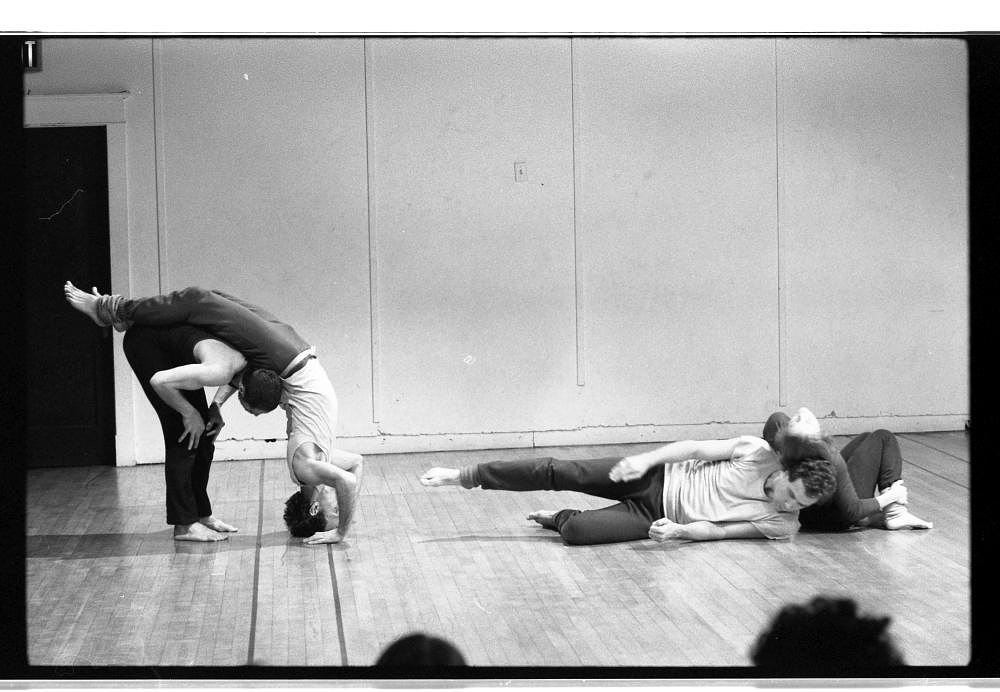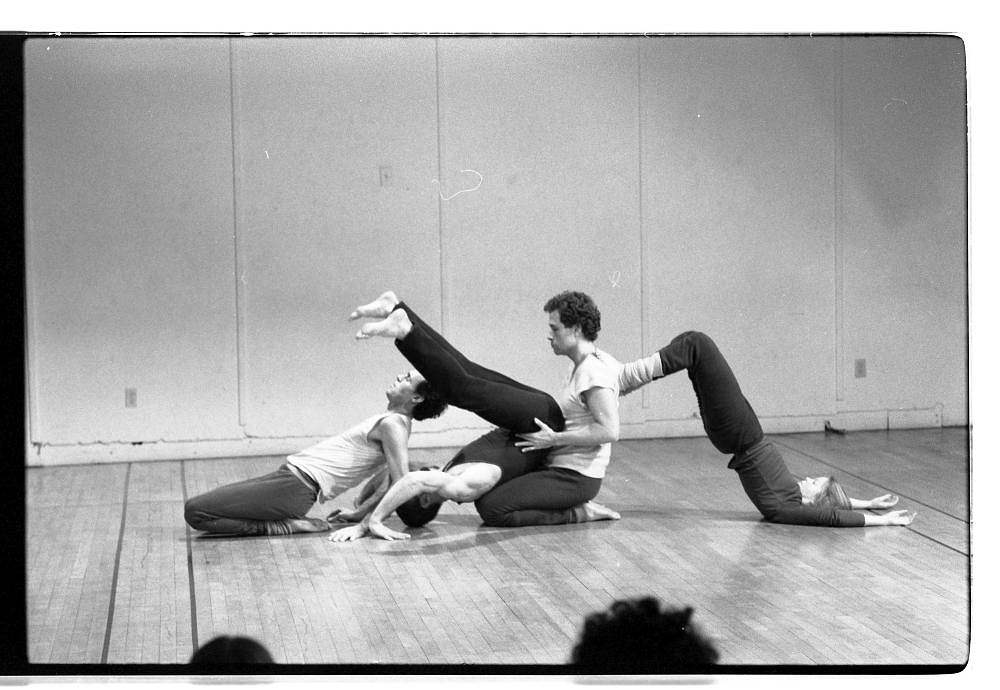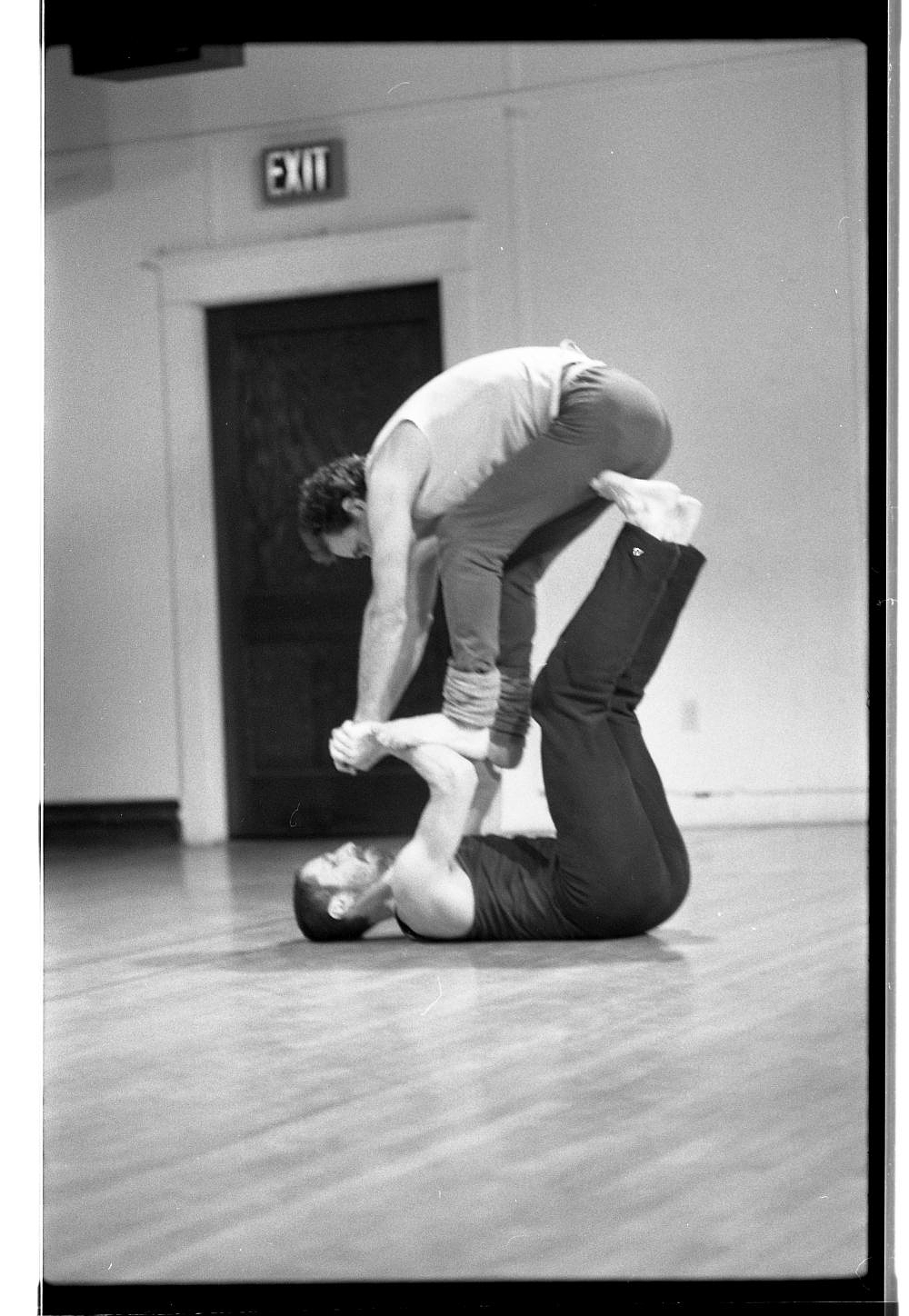
Touch and Tumble
Touch and Tumble is an exhibition of video documentation and works from E.D.A.M. (Experimental Dance and Music) and Western Front’s archives, which capture the early development of the dance form Contact Improvisation within the ground floor studio at Western Front. The exhibition marks the occasion of Contact Improvisation’s 50th year and E.D.A.M.’s 40th year, alongside the commencement of the digitization of E.D.A.M.’s archives.
Contact Improvisation was initiated by American choreographer Steve Paxton in 1972, who described it as “an evolving system of movement ... based on the communication between two moving bodies that are in physical contact and their combined relationship to the physical laws that govern their motion—gravity, momentum, inertia. ... Practice includes rolling, falling, being upside down, following a physical point of contact, supporting and giving weight to a partner.”
Locally, Contact Improvisation was adopted and innovated by Peter Bingham, Helen Clarke, and Andrew de Lotbinière Harwood, who collectively formed the contact-focused company Fulcrum (1977-79), and Lola Ryan, among other dancers who gathered around Linda Rubin’s Synergy Movement Workshops at Western Front in the 1970s. Exchange between local practitioners and East Coast contemporaries, such as Paxton, Lisa Nelson, Nancy Stark Smith, Nita Little, Curt Siddal, and Danny Lepkoff, occured through organised workshops and performances in 1977, 78, and 83.
Presented alongside documentation of such events, are video works made by Steve Paxton and Paul Wong, and Lisa Nelson, in which the principles of Contact Improvisation are applied to video technologies. In Paxton and Wong’s Asteroid (1978) a duet between a dancer and a videographer is staged. Wong uses the camera as the contact point to trace particular phrases of Paxton’s movement, including a giddying pan in which Paxton spins and orbits around Wong at increasing momentum. In Lisa Nelson’s Second Glances (1979), the extended flow of a duet between Alan Ptashek and Nancy Stark Smith is disrupted by a series of devised real-time editing scores. Using ¾” U-matic, Nelson watched two monitors and stood up pushing the editing buttons in and out forcefully, making the activity of editing a full-body interaction with the eyes and one which could bring new flow to the dance.
Together, the material on display offers a glimpse into the history of Contact Improvisation, celebrating its ongoing influence and innovation, including by E.D.A.M. and its Artistic Director, Peter Bingham, who practice it daily behind our gallery wall.


About the Artists
Peter Bingham is the Artistic Director of E.D.A.M., and has been exploring the boundaries of improvisation and choreography since 1975. He is one of the pioneers of Contact Improvisation. The “touch and tumble” of Contact Improvisation is a hallmark of much of Bingham’s choreography, lending both athleticism and graceful elegance to his partnering and ensemble work. Bingham has created over 50 choreographed works and performed in hundreds of improvised performances in theatres, dance festivals, and universities across Canada, the United States, Europe, and Asia.
Helen Clarke is a dancer and was the co-founder of Fulcrum with Peter Bingham and Andrew de Lotbinière Harwood.
Andrew de Lotbinière Harwood is recognized as a pioneer of Contact Improvisation. He began his dance career in 1975, and first studied and then performed with Steve Paxton, Nancy Stark Smith, Nita Little, Kurt Siddal, and Daniel Lepkoff. He has danced for the companies Fulcrum, Joint Forces, Jo Lechay, Jean-Pierre Perreault, and Marie Chouinar, as well as the improvisational dance collectives, The Echo Case, The Improvisational Movement Fund, and Discovery Bal. As a teacher, he transforms all his training and performance experience into a personal language, which he has shared throughout the world since 1977. He was awarded the Canada Council of the Arts Jacqueline Lemieux Award in 2000.
Lisa Nelson is a choreographer, improvisational performer, videographer, and educator who explores the role of the senses in the performance and observation of movement. She is intrigued by dance behaviors, systems of transmission and translation, patterns of surviving culture, and senses of imagination. Her practice “Tuning Scores” is an approach to composition, real-time editing, and communication. Editing in many mediums has been a life practice, including Contact Quarterly dance journal since 1976. Her writings are accessible at oralsite.be. She lives in Vermont, USA.
Steve Paxton has researched the fiction of cultured dance and the “truth” of improvisation for decades. He was one of the founders of the dance groups Judson Dance Theater (1962-66), the Grand Union (1970-76), and Touchdown Dance (for the visually impaired) (1986-ongoing). In 1972, he instigated Contact Improvisation. His two publications Material for the Spine-a movement study (1986) and Gravity (2018) are distributed through Contredanse, Brussels. He lives in Vermont, USA.
Alan Ptashek is a dancer. He formed the Exposed to Gravity Project with Bruce Curtis in the 1980s.
Lola Ryan is a teacher, writer and performer. A former champion athlete, she began a career in dance in her twenties, founding and co-founding several dance and theatre companies and touring nationally. She is one of Canada’s foremost practitioners of dance and movement improvisation. As a critic, she has both written and broadcast reviews of dance and theatre across Canada and in the USA. Her work with children and adults is an abiding interest, which is why the work she has created encourages links between youthful play and the world of dance. Since 2000, Lola has taught thousands of children, adults and seniors at MASC. She also teaches at the University of Ottawa and serves on the board of Dance Ontario.
Nancy Stark Smith (1952-2020) initially trained as an athlete and gymnast, leading her to study and perform modern and postmodern dance in the early 1970s, including graduating from Oberlin College, Ohio with a degree in dance and writing. In 1972, she danced in the first performances of Contact Improvisation with Steve Paxton and others, and continued to be central to its development as a dancer, teacher, performer, organizer, and writer/publisher. In 1975, she co-founded Contact Quarterly, which she co-edited and produced with Lisa Nelson until 2020.
Paul Wong is an artist and curator who is known for pioneering early visual and media art in Canada, founding several artist-run groups, leading public arts policy, and organizing events, festivals, conferences, and public interventions since the 1970s. Writing, publishing, and teaching have been an important part of his praxis. He is the recipient of the 2015 Governor General’s Award in Visual and Media Art and the 2016 Audain Prize for Lifetime Achievement in the Visual Arts.
Acknowledgement
Presented in partnership with E.D.A.M. With special thanks to Julia Carr, Anne Cooper, James Goldie, Margarida Macieira, Diego Romero, Olivia Shaffer, and Abigail Sebaly.
